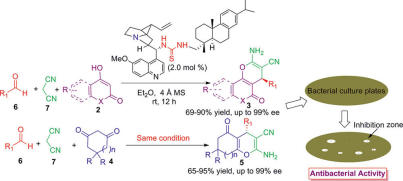Function-oriented design and synthesis of chiral small molecules with novel activity is a key goal in modern organic chemistry. As multiple antibiotic-resistant pathogens are emerging and causing serious diseases, the need for practical routes for the development of new types of antibacterial agents is very urgent.
Researchers from Lanzhou University and Lanzhou Institute of Chemical Physics (LICP), Chinese Academy of Sciences (CAS), have successfully developed a unique approach to asymmetric synthesis of various optically pure pyranocoumarins and 2-amino-4H-chromenes catalyzed by a novel tertiary amine-thiourea with low ligand loading under one-pot, two-component and three-component intermolecular domino reactions with high yield (up to 95%) and enantioslectivities (up to 99% ee). Importantly, preliminary biological studies of these new heterocyclic compounds showed antibacterial activity against S. aureus, MIC = 6.25 μg/mL.
 |
This study discloses a novel type of antibacterial agent and may provide a practical strategy for further developing new types of potent antibiotics efficient against Gram-positive human pathogens.
The work has received support from the National Natural Science Foundation of China and the Key National S & T Program “Major New Drug Development” of the Ministry of Science and Technology. The findings have been published in J. Org. Chem. (J. Org. Chem.2012, 77, 878?888).


